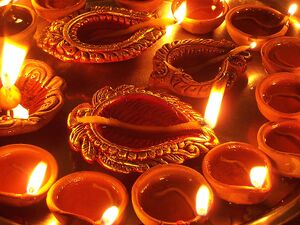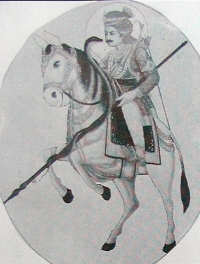Jat festivals
Jump to navigation
Jump to search
Jats celebrate following festivals with great fanfare -
- Akshyatritiya (अक्षयतृतीया) or Ākhātīj (आखातीज) is the special festival of Jats celebrated on the eighteenth day of vaishakh. No muhurt is required for marriages on this day. It is believed that the attempt of Dushasan to Draupudi be shamed by being disrobed in front of the whole court was made imperishable (akshya) by Krishna. Incidentally, according to a folk song Maharaja Surajmal was born on this day.
- Gangadashhara (गंगादशहरा) is observed due to belief that their ancestor Pandavas had gone for first time Gangabath on this day.
- Raksha Bandhan (रक्षा बन्धन) (the bond of protection) or Rakhi (राखी) festival which celebrates the relationship between brothers and sisters. It is celebrated on the full moon of the month of Shraavana. It is associated with Draupadi and Krishna during the Rajsuya yagya. After Shishupal's death, Krishna was left with a bleeding finger. Draupadi, the wife of the Pandavas, had torn a strip of silk off her sari and tied it around Krishna's wrist to staunch the flow of blood. Touched by her concern, Krishna had declared himself bound to her by her love. He further promised to repay the debt manifold. Many years later when Draupudi was about to be shamed by being disrobed in front of the whole court by her evil brother-in-law Duryodhana, she called on Krishna to help her, and he did by divinely elongating her sari so it could not be removed.
- Krishna Janmaashtami (कृष्ण जन्माष्टमी) or "Janmaashtami", is a festival celebrating the birth of Krishna.
- Teej (तीज)is celebrated in many parts of Rajasthan. They worship Goddess Parvati. A day before this festival is celebrated as Sinjara wherein girls/ladies put on mehandi on their hands and eat ghewar/feeni and other sweets. On Teej, married women pray to Goddess Parvati for well being of their husbands. Idols of goddess Parvati are decorated and taken in a procession in the streets accompanied by singing, music, and dancing. Swings are put on trees for ladies.
- Gangaur (गणगौर) is a festival celebrated in Rajasthan, Gujarat and Madhya Pradesh. It is the celebration of spring, harvest and marital fidelity. Gana is a synonym for Lord Shiva and Gaur which stands for Gauri or Parvati who symbolizes Saubhagya (marital bliss). The unmarried women worship her for being blessed good husband, while married women do so for the welfare, health and long life of their husbands and happy married life.
- Chhath (छठ) denotes the number 6 in Hindi and the festival begins on the sixth day of the Hindu lunar calendar month of Kartik, which corresponds to months of October-November in the Gregorian calendar. The festival of Chhath begins a week after Diwali.
- Vijayadashmi (विजयादशमी) or Dussehra celebrates the victory of good over evil. It is the anniversary of the day when Rama killed Ravana in the ancient Hindu epic, Ramayana. For this day Ladies use to make a doll like structure called Snajhi. Sanjhi is made by clay in parts like face feet and star shape structure. With help of cow dung this pieces are given shape on wall. On the eve of Vijay dashmi, they remove it from walls and put it in a pot. The sanjhi with candle is floated in lake(johad).The boys of village use to break that pot. A myth attached to this is "if sanjhi cross the pond safely then this year there will be drought".
- Diwali (दिवाली) celebrates arrival of prince Rama back to Ayodhya after his victory over the evil Ravana as depicted in major Hindu epic of Ramayana. Diwali is one of the most well-known Jat festivals, and is celebrated with great fanfare.For this festival people use to find special kind of weed known as Heedo(हीडो) looks like some root of a tree. Before diwale they bring it and let it dr in sun . On night of diwali they dip it in oil and burn it.
- Makar Sankranti (मकर संक्रान्ति) is a mid-winter festival of India. The day celebrates the northward journey of the Sun. Makar Sankranti is celebrated on January 14, the day the Sun enters the next zodiac sign according to Hindu astrology.People use to take bath very early and Make halwa poori to celebrate this festival.Myth attached to this custom is " if someone does not take bath on this day he will become donkey in his next birth"
- Rama Navami (राम नवमी) falls on the ninth day of a Hindu lunar year (or Chaitra Masa Suklapaksha Navami). This day is the birthday of Rama.
- Holi (होली) is a festival of colours and celebrates the arrival of spring. Legends has that it is celebrated as victory of the faith of Prahlada over evil designs of Hiranyakashipu, who tried to kill him.
- Bāseḍā (बासेड़ा) festival in which people worship "Sheetla Mata (शीतळा माता)," the goddess of small-pox on Sheetla Ashtama day; People don't cook any food and would eat the food made of earlier day. They make seven dishes, the day before and then do pooja and they eat those the whole day. Small pox is supposed to be caused by heat, that is the myth behind this festival.
- Gaṇgaur (गणगौर) - The spring festival of Gangour, symbolic of the ripened harvest is held in honour of Gauri, the goddess of abundance. The image of the diety is carried in a procession by gaily dressed men and women. A sight more exhilarating than the entire population of a city thus assembled for the purpose of rejoicing is hard to imagine.
- Haḷsotiā (हळसोतिया) - festival at the start of plaughing a field. This is an ancient tradition in Jats since Buddha.
- Gogaji (गोगाजी) - Gogaji is a folk deity of Jats in Rajasthan. He is an eminent warrior-hero of the region. Hindus and Muslims alike honor him. He is also venerated as a saint and even as 'snake-god'. He is known as Goga among the Hindus and Jahar Peer among the Muslims. The Kayam Khani Muslims claim descent from him and regard him as a peer (saint). Gogaji is popular as a snake-god and almost every village in Rajasthan has a Than (थान) (sacred place) dedicated to him. The devotees of Gogaji can be found in Uttar Pradesh, Punjab, Madhya Pradesh and Maharashtra. In Gujarat, an annual procession is taken out in honour of the great warrior.
- Gogaji fair - A grand fair is held at Gogamedi, which is 359 km from Jaipur, in Hanumangarh district of Rajasthan in August in memory of Gogaji. It is believed that Gogaji went into samadhi at Gogamedi. Thousands of devotees gather to pay homage at this memorial annually in the month of Bhadrapada during the Gogaji fair, which lasts for 3 days.The fair is held from the ninth day of the dark half of Bhadrapada (Goga Navami) to the eleventh day of the dark half of the same month. The inscription in Persian at the main entrance describes Mahmud of Ghazni's regard for Gogaji. It is quite a sight to see people singing and dancing to the beats of drums and gongs with multicolored flags called 'nishans' in their hands.
- Teja Dashmi (तेजा दशमी) - Tejaji (1074 - 1103) was a Jat folk-deity who lived in the state of Rajasthan in India. Teja Dasami is observed on Bhadrapada Shukla Dashmi by all communities and is celebrated mainly in Rajasthan, Madhya Pradesh and Haryana. Tejaji martyred himself on Bhadrapada Shukla Dashmi in V.S. 1160 (Saturday 28 August 1103 AD) fighting with the enemies for the protection of cows at Sursura, Kishangarh, Ajmer. He was born on 29 January 1074, in the family of Dhaulya gotra Jats. His father was Chaudhary Taharji, a chieftain of Khirnal in Nagaur district in Rajasthan.Veer Teja was a great saint. A large number of temples of Veer Teja have been built in Northern India. It is believed that if a person suffering from snakebite goes to samadhi of Teja or puts a chord (tanti) in Tejaji's name, he is cured. Tejaji fairs are held on the occasion of Teja Dashmi.


